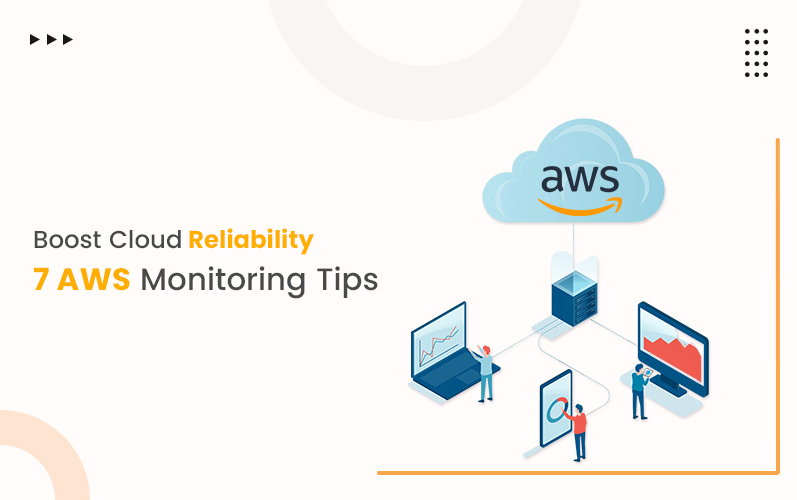AWS monitoring sets the standard for the cloud computing industry today. It is an effective oversight solution that provides optimal performance. Because of this reason, it has become the top pick for over 1.45 million organizations worldwide. But your cloud infrastructure may face a lot of inefficiencies and security challenges if not taken care of properly. Implementing AWS monitoring best practices helps organizations detect issues early. This optimizes resource allocation and maintains seamless application performance. In today's world, 94% of companies depend on cloud services.
So, real-time monitoring is the best strategic edge for your company that maintains the health of your cloud environment. But AWS monitoring is not a simple task. Doing it requires specialization and wide technical expertise.
This blog will immerse you in the world of cloud computing, where you come to know the details of AWS monitoring. It will explore the best practices and the benefits that come with its integration.
An Overview of AWS Monitoring
AWS monitoring is the tracking and analyzing of the performance of AWS resources. These are some sets of practices that check the overall cloud environment. These practices include some monitoring tools like CloudWatch and AWS CloudTrail. The main motive of these tools is to collect real-time metrics. They set automated alerts and ensure smooth operations, optimizing the overall system performance.
To understand how these tools work, you need to know the overview of Amazon Web Services (AWS). AWS (Amazon Web Services) is a powerful cloud platform. It offers scalable computing, storage, and networking solutions. Through AWS monitoring, organizations can detect issues and nip them in the bud.
Key Benefits of AWS Monitoring
For maintaining a healthy cloud environment, AWS monitoring is essential. Regular monitoring practices lead to better performance. This also makes effective use of resources and improves security levels. Thus, you need to implement these practices in your daily schedule.
Here's why in detail:
Enhanced Cloud Server Performance: Consistent monitoring across every cloud server guarantees peak performance. It helps detect anomalies early and maintains seamless system operations for uninterrupted performance.
Improved Resource Optimization: By analyzing usage patterns, AWS monitoring identifies underused resources. This approach optimizes the workloads efficiently and reduces unnecessary costs.
Proactive Issue Detection: Tracking without hindrances provides early alerts on performance drops. It also helps the team to respond quickly and prevent downtime. This helps in continuing business operations without impacting users.
Stronger Security Compliance: AWS monitoring tools track access logs and user activities. They track unusual behaviors while enhancing data protection. Maintaining an effective cloud computing architecture guarantees compliance with industry standards. It safeguards your systems by reducing the risks of unauthorized access.
Comprehensive Visibility and Reporting: A detailed dashboard shows effective AWS monitoring. The team gets a clear picture of your system's health, which makes it easy to create changes if required. They can analyze trends, generate reports, and support data-driven decision-making.
7 Key Practices of AWS Monitoring
Developing an effective AWS monitoring approach involves aligning proven strategies with your organizational goals. When applied correctly, these methods boost performance, enhance security, and ensure consistent cloud efficiency.
Let’s uncover the essential best practices that can strengthen and elevate your AWS monitoring framework:
1. Define Monitoring Goals: Understand what the main requirement of your AWS environment is. Based on that, set your monitoring tools in tune. Identify key performance indicators, resource utilization targets, and alert priorities. Clear objectives help you to set focused monitoring. This enables your team to track meaningful metrics and detect issues faster.
2. Gather & Evaluate Data: Evaluating data from all parts of your AWS environment ensures accurate insights. This is in turn, establishes a seamless monitoring integration. Hire AWS developers who can handle data collection, analyze it, and make integration seamless.
3. Choose Best-Fit Monitoring Tools: For proper monitoring, AWS tools are necessary. Choose reliable tools like Amazon CloudWatch, AWS CloudTrail, and AWS X-Ray. These tools monitor cloud performance, track user activity, and analyze application behavior. These features enhance visibility and operational efficiency.
4. Monitor All Cloud Locations: Track every cloud region carefully. This ensures that each location is free from flaws and provides top-grade performance. Implementing AWS CloudFormation handles code, creates an automated setup, and configures resources. For responding to events and triggers, use AWS Lambda. For tracking changes and strengthening compliance policies, employ AWS Config. Maintain consistent monitoring standards across regions. This helps improve reliability and uptime.
5. Monitor Costs: Monitor AWS expenses regularly. Identify unused or underutilized resources quickly. Set budget alerts to avoid overspending. Analyze billing reports for insights. Analyze billing reports for insights. This ensures efficient cost management and maximizes overall cloud investment value.
6. Organize Resources Effectively: AWS tagging helps to organize resources and track them efficiently. You can take it to the next level using AWS Resource Groups and AWS Cost Explorer. These tools help you manage resources effectively. These tags also help you analyze costs associated with each project and resource. Embracing these latest tools helps create a productive environment.
7. Ensure Security Compliance: Perform regular security audits across your AWS environment. Review configurations and access controls carefully. Identify vulnerabilities before threats occur. Partner with an AWS-certified partner for structured management for compliance verification. This maintains data protection and builds customer trust. Moreover, it boosts visibility, accountability, and operational control.
Final Thoughts
A cloud system environment is an integral part of every company. To make this system stable, AWS monitoring is indispensable. This persistent observation is an ongoing process that ensures stability, security, and cost-efficiency. Employing appropriate AWS monitoring tools and hiring AWS developer professionals strengthens performance.
At The Tech Clouds, we're more than just a service provider. We are your trusted AWS-certified partner. Our team helps detect cost inefficiencies and increase automation processes. We estimate expenses accurately across resources and projects and eliminate unpleasant surprises during billing cycles. We adopt and implement AWS monitoring best practices to safeguard your cloud operations. We detect issues at the budding stage and prevent them from becoming large issues.
Want to simplify your AWS management process? Connect with our developer team today and enjoy seamless cloud performance with us.



